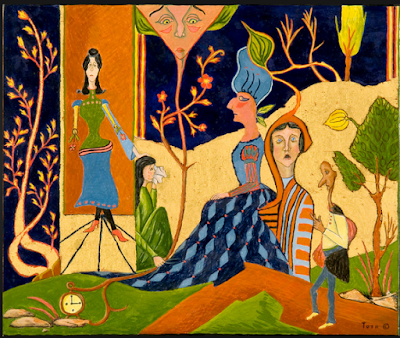 |
| JOSEPHINE TOTA, egg tempera and gilt on board |
Mary Doria Russell’s famous science-fiction novel, THE SPARROW, was published in 1996. In it, Russell tells a story of an international team of scientists and linguists, led by a Jesuit, who set out to follow and determine the source of ethereal music. They ultimately land on a foreign planet and begin interaction among its population. Things do not go well.
The story speaks to the issues of faith — religious faith and faith in cultural and scientific certainty. The instigators of such beautiful music turn out to adhere to every sort of debauchery. The explorers are murdered; only the Jesuit priest is spared and he submits to indescribable indignities. His god abandons him.
His hands are disfigured, bones removed to indicate that he is useless for anything other than as an object, to be used for sex, and admired for beauty and lust.
It’s a horrifying tale but one practiced in not-so-subtle ways throughout history in earthbound cultures. Think of foot binding. It doesn’t take long before this trail leads through the era of corsets, binding clothing, bridal veils, stiletto shoes and the practice of total control of part of a population (usually male) over another (usually female.)
 |
| Josephine Tota |
The exhibition at Memorial Art Gallery featuring the painter Josephine Tota brought the story of THE SPARROW back to me as soon as I saw the image used on the show announcement. I was already flinching before I ever walked into the main gallery to see all 90 paintings.
Tota’s back story: she was born in 1910 and died in 1996. She spent her working years as a seamstress and amateur artist. It’s important to imagine her sources of inspiration. She was an Italian immigrant and these paintings relate strongly to Italian Catholic iconography. They are small works, painted in egg tempera with gold gilding, and the colors she used were intense, jewel rich — rarely anything pastel.
Obviously, she knew women, their shapes, proportions (and undoubtedly their personal stories) from years of stitching their clothing. Because she came “of age” during the 1930’s, it is reasonable to assume that the great age of Art Deco left it’s stamp on her stylistically. After all, we are tattooed by those years when we are most aware of image, fashion, and the adult facade. Her women often have the same elongated bodies similar to Erte’s illustration.
What label to classify these fantasy scenes? Surrealism comes closest: unnerving, illogical scenes but with precise detail. Surrealism combines dreams and reality. Figures are often biomorphic (think Henry Moore sculpture.) The movement began in Europe and spread to the U.S. during the 1930s and is considered one of the first modernist art movements. Surrealism gave a unique form to feminine imagery and social institutions that previously relegated women to a lesser role among art patrimony.
All that is evident in Tota’s paintings. And if you are a fan of surrealism art or if you just want to see more of the form, by all means, this is your stop.
I’ve been puzzling over this show for the past week and finally decided that while Tota’s is a unique and consistent vision, it’s one that doesn’t particularly move me. And that’s O.K. But one of the reasons I am put off by this exhibit is NOT so O.K. I think our museum has done a dreadful job of presenting this work. I don’t like the framing, I don’t like the color on the walls, I hate the lighting and I don’t even much like the explanations that accompany the paintings themselves.
I resent the story line presented with her paintings. I met Ms.Tota back in the 1980s. She seemed to me to be a pretty confident, feisty little lady. I hate having her portrayed now as less than that. Instead, we are told in the press releases and label postings, that Tota suffered personally from loneliness, isolation, and depression. I think, in her paintings, she was saying “I am woman. Welcome to my — and your — world.”
 |
| Surrealism by Dorothea Tanny, 1910 - 2012 |
 |
| Drea, reality, detail (Dorothea Tanny) Oil on canvas |


1 comment:
I learn so much from your blog, Shirley. Thank you for sharing your knowledge and insights.
Veronica Miller
Post a Comment